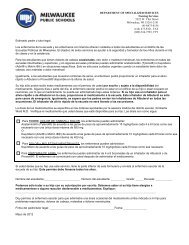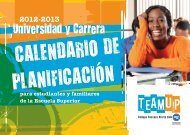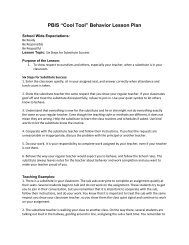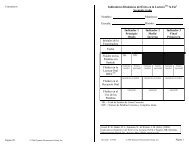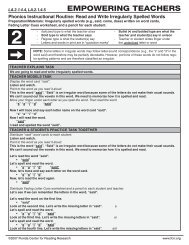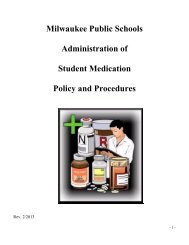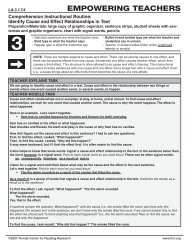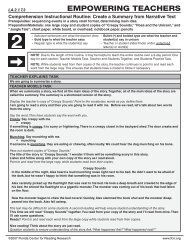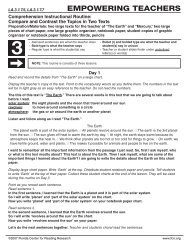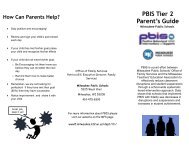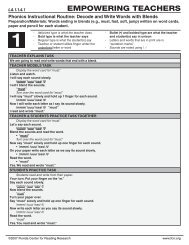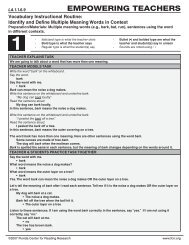Identify Base Words and Suffixes to
Identify Base Words and Suffixes to
Identify Base Words and Suffixes to
You also want an ePaper? Increase the reach of your titles
YUMPU automatically turns print PDFs into web optimized ePapers that Google loves.
LA.3.1.4.1<br />
EMPOWERING TEACHERS<br />
Phonics Instructional Routine:<br />
<strong>Identify</strong> <strong>Base</strong> <strong>Words</strong> <strong>and</strong> Affixes <strong>to</strong> Read Multi-Syllabic <strong>Words</strong> #2<br />
Prerequisites: Third Grade Vocabulary Instructional Routine: Determine the Meaning of a Word<br />
using Knowledge of <strong>Base</strong> <strong>Words</strong> <strong>and</strong> Affixes <strong>and</strong> Third Grade Phonics: <strong>Identify</strong> <strong>Base</strong> <strong>Words</strong> <strong>and</strong><br />
<strong>Suffixes</strong> <strong>to</strong> Read Multi-Syllabic <strong>Words</strong> #1<br />
Preparation/Materials: Whiteboard <strong>and</strong> marker or word cards for the following words <strong>and</strong> affixes.<br />
Prefixes: pre-,un-, mis-, re-, de-. <strong>Suffixes</strong>: -able, -ful, -ly, -ment, -less. <strong>Words</strong>: pay, cook, tax, scribe,<br />
place, match, take, kind, happy, fair, do, make, print, gain, part, rail, compose, like, return, agree,<br />
power, watch, fear, state, friend, employ<br />
3<br />
-<br />
-<br />
-<br />
TEACHER EXPLAINS TASK<br />
Italicized sentences are what the teacher does<br />
Bold type is what the teacher says<br />
Regular type is what the student(s) say<br />
We are going <strong>to</strong> read words with prefixes <strong>and</strong> suffixes.<br />
TEACHER MODELS TASK<br />
©2007 Florida Center for Reading Research www.fcrr.org<br />
-<br />
-<br />
Bullet (•) <strong>and</strong> bolded type are what the teacher <strong>and</strong><br />
student(s) say in unison<br />
Teacher or student slides finder under underlined<br />
letter(s) or word(s)<br />
We often encounter long, unfamiliar words during reading. One way that we can read a bigger word is <strong>to</strong> break that<br />
word in<strong>to</strong> parts by identifying the base word, prefix, <strong>and</strong> suffix.<br />
A base word is a word that can have a prefix or a suffix added <strong>to</strong> it. When a prefix or suffix is added <strong>to</strong> a base word,<br />
the word’s meaning changes <strong>and</strong> a new word is formed.<br />
A prefix is added <strong>to</strong> the beginning of a base word.<br />
Where is a prefix added <strong>to</strong> a base word<br />
• A prefix is added <strong>to</strong> the beginning of a base word.<br />
The suffix is added <strong>to</strong> the end of a base word.<br />
Where is a suffix added <strong>to</strong> a base word<br />
• The suffix is added <strong>to</strong> the end of a base word.<br />
Let’s start with prefixes.<br />
Put the prefix cards on the board or in the chart holder: pre-, un-, mis-, re-, de-<br />
Let’s read some prefixes before we add them <strong>to</strong> a base word.<br />
Point <strong>to</strong> each prefix as you say it.<br />
This prefix is pre-, meaning before, as in pretend.<br />
What is this prefix<br />
• pre-<br />
Spell pre.<br />
• p-r-e<br />
Say pre- again.<br />
• pre-<br />
This prefix is un-, meaning not, as in unfair.<br />
What is this prefix<br />
• un-<br />
Spell un.<br />
• u-n<br />
Say un- again.<br />
• un-<br />
Continue this pattern with the other prefixes: mis-, re-, <strong>and</strong> de-, using the words misplace, replay, <strong>and</strong> defrost. Mis- means<br />
wrongly, re- means again, de- means opposite of.<br />
Now, let’s read this list of prefixes without s<strong>to</strong>pping. Point as you read aloud.<br />
• pre-, un-, mis-, re-, de-<br />
Read the list of prefixes again, a little faster. Once the students can read each prefix, do a quick word sort <strong>to</strong> match the<br />
prefixes <strong>and</strong> meanings.
TEACHER MODELS TASK (continued)<br />
EMPOWERING TEACHERS<br />
These prefixes can be added <strong>to</strong> words you already know <strong>to</strong> make new words. Point as you read aloud.<br />
First, let’s read these words <strong>to</strong>gether:<br />
• pay, cook, tax, scribe, place, match, take, kind, happy, fair, do, make, print, gain, part, rail, compose.<br />
Discuss the meaning of any word that may be unfamiliar <strong>to</strong> the students.<br />
Now, we will make new words by adding the prefixes.<br />
First, we’ll say the prefix. Then, we’ll say the base word. Finally, we’ll read the new word.<br />
Point <strong>to</strong> each part. Pause when reading each word part.<br />
• pre + pay = prepay<br />
What’s the word… prepay<br />
• pre + cook = precook<br />
What’s the word… precook<br />
• pre + tax = pretax<br />
What’s the word. ..pretax<br />
• pre + scribe = prescribe What’s the word…prescribe<br />
• mis + place = misplace<br />
• mis + match = mismatch<br />
• mis + take = mistake<br />
What’s the word…misplace<br />
What’s the word …mismatch<br />
What’s the word…mistake<br />
Have students make new words in the same manner with the remaining prefixes: un: unkind, unhappy, unfair; re: redo,<br />
remake, reprint, regain; de: depart, derail, decompose.<br />
Again, let’s read all the words with prefixes.<br />
Point <strong>to</strong> each word as you <strong>and</strong> the students read it aloud. You can go in order under each prefix or point <strong>to</strong> words r<strong>and</strong>omly.<br />
• prepay, precook, pretax, prescribe, misplace, mismatch, mistake, unkind, unhappy, unfair, redo, remake,<br />
reprint, regain, depart, derail, decompose.<br />
Now, let’s sort these words by listing all the words that begin with a prefix that means wrongly (mis-). Continue with<br />
the remaining words <strong>and</strong> prefixes (pre-, re-, de-). Write the definitions for each prefix in a row across the whiteboard.<br />
Point <strong>to</strong> <strong>and</strong> read aloud each word then ask the students where the word should go. Or, you can give each student a card<br />
with the definition of the prefix, a card for each prefix, <strong>and</strong> one for each word so that they can sort the words.<br />
Great job reading <strong>and</strong> sorting those words!<br />
Sometimes we encounter long, unfamiliar words during reading. Let’s practice what <strong>to</strong> do when there is an<br />
unfamiliar word.<br />
Tell the students you are going <strong>to</strong> read the following sentence aloud but do not read the underlined word, describe. This will<br />
be your word <strong>to</strong> model.<br />
The teacher asked me <strong>to</strong> describe the picture on the wall.<br />
I don’t know this word here. Point <strong>to</strong> describe.<br />
First, I break it in<strong>to</strong> parts. You can use your fingers or h<strong>and</strong>s <strong>to</strong> show the parts.<br />
de- scribe<br />
Then, I name the prefix or suffix.<br />
de- is the prefix. De- means opposite of<br />
Next, I name the base word.<br />
Scribe is the base word. Scribe means <strong>to</strong> write.<br />
Finally, I read the whole word.<br />
Describe. Describe means the opposite of writing. If we want <strong>to</strong> tell about something <strong>and</strong> we do the opposite of<br />
writing about it, we can talk about it.<br />
Now, I’m going <strong>to</strong> reread the whole sentence aloud.<br />
The teacher asked me <strong>to</strong> describe the picture on the wall.<br />
This means the teacher wanted me <strong>to</strong> talk about (describe) the picture.<br />
This is one thing that you can do when you encounter an unfamiliar word.<br />
TEACHER AND STUDENTS PRACTICE TOGETHER<br />
Remember, one way that we can read a bigger word is <strong>to</strong> break that word in<strong>to</strong> its base word, prefix, <strong>and</strong> suffix.<br />
What can we do <strong>to</strong> read a bigger word<br />
• We can break the word in<strong>to</strong> its base word, prefix, <strong>and</strong> suffix.<br />
©2007 Florida Center for Reading Research www.fcrr.org
TEACHER AND STUDENTS PRACTICE TOGETHER (continued)<br />
The prefix is added <strong>to</strong> the beginning of a base word.<br />
Where is a prefix added <strong>to</strong> a base word<br />
• The prefix is added <strong>to</strong> the beginning of a base word.<br />
The suffix is added <strong>to</strong> the end of a base word.<br />
Where is a suffix added <strong>to</strong> a base word<br />
• The suffix is added <strong>to</strong> the end of a base word.<br />
EMPOWERING TEACHERS<br />
When a prefix or suffix is added <strong>to</strong> a base word, the word’s meaning changes <strong>and</strong> a new word is formed.<br />
What happens when a prefix or suffix is added <strong>to</strong> a base word<br />
• The word’s meaning changes <strong>and</strong> a new word is formed.<br />
That’s right.<br />
Let’s read some suffixes before we add them <strong>to</strong> a base word.<br />
Put the suffix cards on the board or in the chart holder: -able, -ful, -ly, -ment, -less.<br />
Point <strong>to</strong> each suffix as you say it.<br />
This suffix is -able, meaning can be or capable of, as in drinkable.<br />
What is this suffix<br />
• -able<br />
Spell able.<br />
• a-b-l-e<br />
Say -able again.<br />
• -able<br />
This suffix is -ful, meaning full of, as in careful.<br />
What is this suffix<br />
• -ful<br />
Spell ful.<br />
• f-u-l<br />
Say -ful again.<br />
• -ful<br />
Continue this pattern with the other suffixes: -ly, meaning characteristic of; - ment, meaning action or process; <strong>and</strong> -less,<br />
meaning without. Use the words costly, movement, <strong>and</strong> speechless.<br />
Now, let’s read this list of suffixes without s<strong>to</strong>pping.<br />
• -able, -ful, -ly, -ment, -less<br />
Have students read the list of suffixes again, a little faster. Once the students can read each suffix, do a quick word sort <strong>to</strong><br />
match the suffixes <strong>and</strong> meanings.<br />
These suffixes can be added <strong>to</strong> words you already know <strong>to</strong> make a new word.<br />
First, let’s read these words <strong>to</strong>gether:<br />
• like, return, agree, power, watch, fear, state, friend, employ<br />
Discuss the meaning of any word that may be unfamiliar <strong>to</strong> the students.<br />
Now, we will make new words by adding the suffixes.<br />
First, we’ll say the base word. Then, we’ll say the suffix. Finally, we’ll read the new word.<br />
Point <strong>to</strong> each part. Pause for a second when reading each word part.<br />
• like + able = likeable<br />
What’s the word…likeable<br />
• return + able = returnable What’s the word…returnable<br />
• agree + able = agreeable What’s the word...agreeable<br />
• employ + able = employable What’s the word…employable<br />
• power + ful = powerful<br />
• watch + ful = watchful<br />
• fear + ful = fearful<br />
What’s the word…powerful<br />
What’s the word…watchful<br />
What’s the word…fearful<br />
Have students make new words in the same manner with the remaining suffixes: -ly: likely, stately, friendly; -ment: statement,<br />
agreement, employment; -less: powerless, fearless, friendless.<br />
©2007 Florida Center for Reading Research www.fcrr.org
TEACHER AND STUDENTS PRACTICE TOGETHER (continued)<br />
EMPOWERING TEACHERS<br />
Again, let’s read all the words with suffixes.<br />
Point <strong>to</strong> each word as you <strong>and</strong> the students read it aloud. You can go in order or point <strong>to</strong> words r<strong>and</strong>omly.<br />
• likeable, returnable, agreeable, employable, powerful, watchful, fearful, likely, stately, friendly, statement,<br />
agreement, employment, powerless, fearless, friendless.<br />
Now, let’s sort these words by listing all the words that begin with a suffix that means can be (-able). Continue with<br />
the remaining words <strong>and</strong> prefixes (-ful, -ly, -ment, -less).<br />
Write the definition for each suffix in a row across the whiteboard. Point <strong>to</strong> <strong>and</strong> read aloud each word. Then, ask the<br />
students where the word should go. Or, you can give each student a card with the definition of the suffix, a card for each<br />
suffix, <strong>and</strong> one for each word so that they can sort the words.<br />
Those were hard words. You did an excellent job of reading <strong>and</strong> sorting all the words.<br />
Sometimes we encounter long, unfamiliar words during reading. Let’s practice what <strong>to</strong> do when there is an<br />
unfamiliar word.<br />
Tell the students you are going <strong>to</strong> read the following sentence aloud but do not read the underlined word, taxable. This will<br />
be your word <strong>to</strong> model.<br />
Do you know if <strong>to</strong>ys are taxable<br />
I don’t know this word here. Point <strong>to</strong> taxable.<br />
First, I break it in<strong>to</strong> parts. You can use your fingers or h<strong>and</strong>s <strong>to</strong> show the parts.<br />
• tax able<br />
Then, I name the prefix or suffix.<br />
-able is the suffix. –able means can be<br />
Next, I name the base word.<br />
Tax is the base word. Tax is a fee that is added <strong>to</strong> the cost of buying something.<br />
Finally, I read the whole word.<br />
Taxable. Taxable means that a tax can be added <strong>to</strong> the cost of what you are buying.<br />
Now, I’m going <strong>to</strong> reread the whole question aloud.<br />
Do you know if <strong>to</strong>ys are taxable<br />
This is a question that asks if a tax can be added <strong>to</strong> the cost of the <strong>to</strong>y.<br />
Remember, this is one thing that you can do when you encounter an unfamiliar word.<br />
STUDENTS PRACTICE TASK<br />
What is one thing that we can do <strong>to</strong> read a bigger word<br />
We can break a word in<strong>to</strong> the base word <strong>and</strong> the prefix or suffix.<br />
That’s right.<br />
Where is a prefix when it is added <strong>to</strong> a base word<br />
The prefix is added <strong>to</strong> the beginning of a base word.<br />
Where is a suffix when it is added <strong>to</strong> a base word<br />
The suffix is added <strong>to</strong> the end of a base word.<br />
Remember, when you encounter a long, unfamiliar word you can break that word in<strong>to</strong> the base word <strong>and</strong> the prefix<br />
or suffix <strong>to</strong> read it.<br />
Read this sentence. Point <strong>to</strong> each word as students read aloud.<br />
The flat tire on the bus caused a great misadventure during the field trip.<br />
Let’s say you don’t know this word here. Point <strong>to</strong> misadventure.<br />
First, break it in<strong>to</strong> parts. You can use your fingers or h<strong>and</strong>s <strong>to</strong> show the parts.<br />
Mis adventure<br />
Then, name the prefix or suffix.<br />
Mis- is the prefix.<br />
What is the meaning of mis<br />
Mis- means wrong or wrongly<br />
Next, name the base word.<br />
Adventure is the base word.<br />
Adventure means an experience or trip.<br />
©2007 Florida Center for Reading Research www.fcrr.org
STUDENTS PRACTICE TASK (continued)<br />
EMPOWERING TEACHERS<br />
Finally, read the whole word.<br />
Misadventure<br />
Yes. Misadventure means <strong>to</strong> have an experience or adventure that goes wrong.<br />
Now, reread the whole sentence aloud.<br />
The flat tire on the bus caused a great misadventure during the field trip.<br />
This can be repeated with several sentences using new words with the previously taught suffixes <strong>and</strong> prefixes.<br />
INDEPENDENT PRACTICE<br />
When students consistently identify the base word, suffix, <strong>and</strong> prefix that are taught in this routine, provide opportunities <strong>to</strong><br />
practice individually or in pairs using new words.<br />
SCAFFOLDING SUGGESTION FOR ERRORS<br />
Verify that students are correctly identifying the base word, prefix, <strong>and</strong> suffix. If students are experiencing difficulty with this<br />
concept, reduce the routine <strong>to</strong> base words <strong>and</strong> prefixes or suffixes Provide more practice reading the new words before<br />
adding a new difficulty. Explain <strong>to</strong> students that the suffix, able, begins with the letter a, but when it is used at the end of a<br />
word it has the schwa sound so it is pronounced as /uble/.<br />
Adaptations using this Instructional Routine:<br />
• When the students are doing well with this routine, vary it by combining the prefixes <strong>and</strong> suffixes <strong>to</strong> new base words.<br />
For further independent practice, refer <strong>to</strong> the following Second <strong>and</strong> Third Grade FCRR Student Center<br />
Activities at http://www.fcrr.org/Curriculum/PDF/G2-3/2-3Phonics_5.pdf<br />
• P.039 <strong>Base</strong> words <strong>and</strong> inflectional endings<br />
• P.040 <strong>Base</strong> words <strong>and</strong> inflectional endings<br />
• P.041 <strong>Base</strong> words <strong>and</strong> affixes<br />
• P.042<br />
• P.043<br />
• P.044<br />
©2007 Florida Center for Reading Research www.fcrr.org



